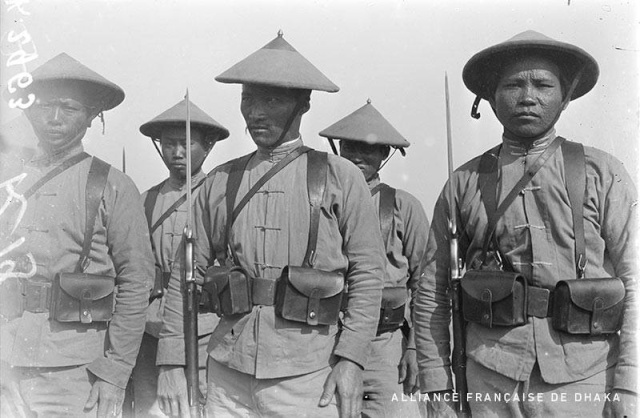 ### Fusil Mle 1902 and Mle 1907
### Fusil Mle 1902 and Mle 1907
[edit]
After the success of the Berthier carbines or mousquetons, two full-length Berthier rifles were introduced during the years preceding World War I. They were the fusil Mle 1902 (“rifle, model of 1902”) and the fusil Mle 1907, which were issued respectively to Indochinese and Senegalese Tirailleur troops. Lighter and easier to handle and load than the Mle 1886/M93 Lebel rifle, the Berthier rifles proved more suitable for offhand shooting and easier to maintain in tropical environments. In comparison to the Mle 1886 Lebel, the Berthier’s sights were also wider, higher and more substantial. Like their shorter carbine counterparts, these Berthier rifles also featured a Mannlicher-type 3-round en bloc clip-loaded magazine and used 8 mm Lebel ammunition. The Mle 1902 and Mle 1907 were made on special order and in small numbers (altogether about 5,000 rifles) by the Manufacture d’Armes de Châtellerault.


Only the Carbine version of the gun is in the game with the Moroccan squad. Including the full rifle with another Asian French colonial division might be nice. Of course Germany might try to claim it because some record of Germany using five of them in some battle. While most of the soldiers that fought and died in ww2 were white just ask ussr. the war touched every corner of the world and almost every nation. WW2 was not just the end of the axis but slowly the end of western colonialism. Many countries like india would finally gain independence. Adding units from these countries would not only add historical weapon but show the very global nature of the conflict.  . World War II
. World War II
[edit]
Berthier rifles and carbine continued in service during the Second World War in all branches of French service, including infantry and mounted units. Colonial and Foreign Legion forces in particular continued to use the Mle 1916 Berthier due to a shortage of the new MAS-36 bolt-action rifle. Despite the advent of the MAS-36, the French Army did not have enough of the new rifles to equip even half of its frontline interior troops. Berthier Model 1916 (original and converted) 5-shot rifles and carbines saw action in both France and Norway. After the fall of France in 1940, the Berthier could be found in service with both Vichy and Free French units. Selected Berthier Mle 1907/15-M16 (Fusil Mle 1916) rifles were fitted with telescopic sights and used, along with scoped Mle 1886/M93 rifles, by marksmen detailed to serve with some French units. In September 1938, the French Army also introduced the corps franc, special formations of infiltration and deep reconnaissance soldiers formed into l’equipe or assault teams. These elite reconnaissance and infiltration troops were equipped with a variety of small arms, including a combat knife, a handgun, grenades, and Berthier Mle 1892/M16 carbines.
The Mle 1890M16, 1892M16 and Mle 1916 mousquetons) were again used by French Foreign Legion and some colonial infantry and cavalry units, including the French Spahis. The Greek Army still fielded Berthier Mle 07/15M16 rifles during the Greco-Italian War, most being used in second-line units.[11] The Third Reich issued many captured Berthier carbines to German occupation forces in France, mainly to Atlantic Wall units, the M34 variant received the German identification code Gewehr 241(f). Some were used by police units fighting partisans in various eastern European countries including security units operating at the rear of German front lines in Soviet Union. 